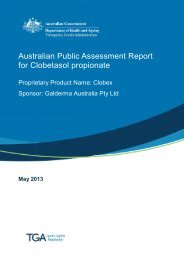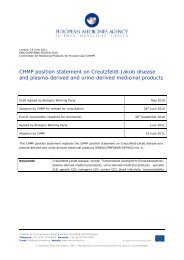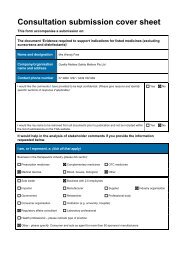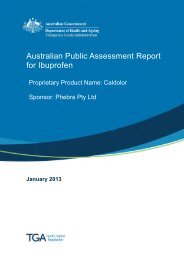AusPAR: Ivabradine - Therapeutic Goods Administration
AusPAR: Ivabradine - Therapeutic Goods Administration
AusPAR: Ivabradine - Therapeutic Goods Administration
Create successful ePaper yourself
Turn your PDF publications into a flip-book with our unique Google optimized e-Paper software.
<strong>AusPAR</strong> Coralan <strong>Ivabradine</strong> Servier Laboratories (Australia) Pty Ltd PM-2010-03269-3-3<br />
Final 31 October 2012<br />
<strong>Therapeutic</strong> <strong>Goods</strong> <strong>Administration</strong><br />
(asymptomatic and symptomatic) or arrhythmias in this subgroup and hence assist in<br />
determining the profile of CHF patient population for which ivabradine should be<br />
indicated in terms of concomitant use of beta blockers.<br />
Evaluator’s overall conclusions on clinical safety<br />
Overall, the incidence of TEAEs and SAEs was comparable between the 2 treatment<br />
groups. However, the incidences of treatment-related TEAEs and treatment-related SAEs<br />
were higher in the ivabradine group than in the placebo group (17.8% versus 8.3% and<br />
2.0% versus 1.3%, respectively) (Table 17).<br />
Table 17. Overall summary of safety results. All clinical events on treatment (Safety Set)<br />
The most commonly occurring treatment-related TEAEs in the ivabradine group were<br />
known adverse effects of ivabradine stated in the currently approved PI.<br />
In the section on SAEs in the proposed PI, it is stated that “the most frequently reported<br />
SAEs with ivabradine were Cardiac disorders, where the only SAE reported with a ≥1%<br />
incidence was unstable angina (1.5%)”. Results in the SHIFT study showed that the most<br />
frequently reported treatment-related SAEs by SOC in the ivabradine group was also<br />
cardiac disorders (1.7% versus 0.6% in the ivabradine and placebo groups, respectively).<br />
All treatment-related SAEs by preferred term occurred at an incidence rate of < 0.5%, the<br />
commonest being cardiac failure (0.4% versus 0.3% in the ivabradine and placebo groups,<br />
respectively), symptomatic bradycardia (0.4% versus
















